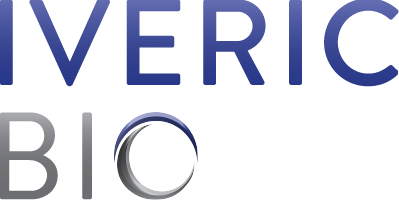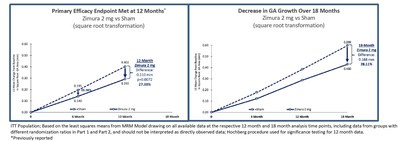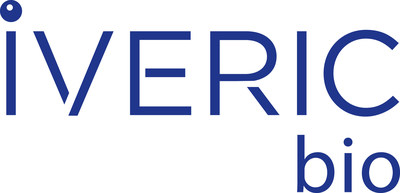Iveric Bio Announces Positive Zimura 18 Month Data Supporting the 12 Month Efficacy Findings: Continuous Positive Treatment Effect with Favorable Safety Profile in Geographic Atrophy Secondary to Age-Related Macular Degeneration in a Phase 3 Trial
In this trial, the treatment effect was observed as early as 6 months, with an increase in the absolute difference of the mean change in GA growth for treatment with either Zimura 2 mg or Zimura 4 mg, as compared to sham, at each subsequent time point, suggesting the progressive benefit of continuous treatment with Zimura. Zimura maintained its favorable safety profile at 18 months with no reported Zimura related adverse events, no cases of endophthalmitis and a lower rate of choroidal neovascularization (CNV) than reported for C3 inhibition. The overall 18 month data may suggest a dose response relationship.
"We are extremely excited by the new 18 month data from this Phase 3 clinical trial, both with respect to efficacy and safety," stated
"We are one step closer to potentially bringing a clinically meaningful therapy to patients with GA who currently do not have any FDA or EMA approved treatments available to them," stated
The Company previously announced that in the OPH2003 clinical trial, Zimura met its pre-specified primary efficacy endpoint at 12 months and reached statistical significance in the international, multicenter, randomized, double masked, sham controlled clinical trial in GA secondary to AMD. The reduction in the mean rate of GA growth over 12 months was 27.38% (p-value = 0.0072) for the Zimura 2 mg group as compared to the corresponding sham control group and 27.81% (p-value = 0.0051) for the Zimura 4 mg group as compared to the corresponding sham control group. The data for both dose groups were statistically significant.
"I am excited about the efficacy and favorable safety profile observed in the 12 month Zimura Phase 3 data, and now the long term 18 month efficacy and safety data further confirm my belief in the role of complement C5 inhibition in the treatment of GA," stated
"We are excited by these 18 month results," stated Pravin U. Dugel, MD, Executive Vice President and Chief Strategy and Business Officer of IVERIC bio. "In the challenging COVID-19 pandemic era, we believe that we are in an advantageous position as the OPH2003 data is the only positive Phase 3 clinical data in GA secondary to AMD that we are aware of that has been reported to date. We believe that these robust data should increase investigator enthusiasm and confidence for patient recruitment and retention in our ISEE2008 clinical trial."
OPH2003 18 Month Data
A total of 286 patients were enrolled in this trial.
Mean rate of change in GA growth over 18 months, was measured by fundus autofluorescence (FAF) based on readings at four time points (baseline, month 6, month 12 and month 18) and was calculated using the square root transformation of the GA area. The FAF images were assessed by an independent masked reading center. The prespecified statistical analysis plan used a model of repeated measures (MRM) to compare data for the Zimura 2 mg and Zimura 4 mg groups to the corresponding sham groups. Detailed data are shown below:
|
Mean Rate of Change in Geographic Atrophy (GA) Area from Baseline to Month 18 |
|||||
|
Cohort |
Zimura 2 mg ( |
Sham (N = 110) |
Difference |
% Difference |
P-Value (Descriptive) |
|
Mean Change in GAa (mm) |
0.430 |
0.599 |
0.168 |
28.11% |
0.0014 |
|
Cohort |
Zimura 4 mg (N = 83) |
Sham (N = 84) |
Difference |
% Difference |
P-Value (Descriptive) |
|
Mean Change in GAb (mm) |
0.391 |
0.559 |
0.167 |
29.97% |
0.0021 |
|
a Based on least squares means from MRM model, these least square means are from the MRM model, drawing on all available data at the month 18 time point, including data from groups with different randomization ratios in Part 1 and Part 2, and should not be interpreted as directly observed data. |
|||||
The graphs below illustrate the observed difference in mean rate of GA growth between each of the Zimura 2 mg and Zimura 4 mg treatment groups and their corresponding sham control groups based on the MRM analysis at both 12 months (which was previously reported) and 18 months.
Zimura was generally well tolerated after 18 months of administration. There was no Zimura-related inflammation, no Zimura-related discontinuations from the trial, no cases of endophthalmitis and no Zimura-related adverse events. Through month 18, the reported incidence of CNV in the untreated fellow eye was 11 patients (3.8%), and in the study eye was 3 patients (2.7%) in the sham control group, 8 patients (11.9%) in the Zimura 2 mg group, and 13 patients (15.7%) in the Zimura 4 mg group. The most frequently reported ocular adverse events were related to the injection procedure.
The Company plans to make additional supportive information regarding the 18 month results available in its public filings with the
Geographic Atrophy
Age-related macular degeneration (AMD) is the major cause of moderate and severe loss of central vision in aging adults, affecting both eyes in the majority of patients. The macula is a small area in the central portion of the retina responsible for central vision. As AMD progresses, the loss of retinal cells and the underlying blood vessels in the macula results in marked thinning and/or atrophy of retinal tissue. Geographic atrophy, the advanced stage of AMD, leads to further irreversible loss of vision in these patients. There are currently no
Zimura
Complement factor C5 is a central component of the complement cascade and is believed to be involved in the development and progression of AMD. Zimura is designed to inhibit complement factor C5 cleavage into C5a and C5b. By inhibiting the formation of complement C5 terminal fragments, Zimura may decrease the activation of inflammasomes and the formation of membrane attack complex (MAC). This mechanism of action could potentially prevent or slow down the degeneration of retinal pigment epithelial (RPE) cells and slow down the progression of GA.
Conference Call/Web Cast Information
IVERIC bio's management team will host a conference call/webcast today at
IVERIC bio
IVERIC bio is a science-driven biopharmaceutical company focused on the discovery and development of novel treatment options for retinal diseases with significant unmet medical needs. The Company is currently developing both therapeutic product candidates for age-related retinal diseases and gene therapy product candidates for orphan inherited retinal diseases. Vision is Our Mission. For more information on the Company, please visit www.ivericbio.com.
Forward-looking Statements
Any statements in this press release about the Company's future expectations, plans and prospects constitute forward-looking statements for purposes of the safe harbor provisions under the Private Securities Litigation Reform Act of 1995. Forward-looking statements include any statements about the Company's strategy, future operations and future expectations and plans and prospects for the Company, and any other statements containing the words "anticipate," "believe," "estimate," "expect," "intend", "goal," "may", "might," "plan," "predict," "project," "seek," "target," "potential," "will," "would," "could," "should," "continue," and similar expressions. In this press release, the Company's forward looking statements include statements about the impact of the COVID-19 pandemic on the Company's research and development programs, operations and financial position, its expectations to initiate enrollment in its second Phase 3 trial (ISEE2008) of Zimura in geographic atrophy secondary to AMD and to use its previously announced clinical trial of Zimura for the treatment of geographic atrophy (OPH2003) as a Phase 3 trial, its development and regulatory strategy for Zimura, the potential clinical meaningfulness of the results of clinical trials, the implementation of its business plan, the projected use of cash and cash balances, the timing, progress and results of clinical trials and other research and development activities, the potential utility of its product candidates, and the potential for its business development strategy. Such forward-looking statements involve substantial risks and uncertainties that could cause the Company's development programs, future results, performance or achievements to differ significantly from those expressed or implied by the forward-looking statements. Such risks and uncertainties include, among others, those related to the progression and duration of the COVID-19 pandemic and responsive measures thereto and related effects on the Company's research and development programs, operations and financial position, the initiation and the progress of research and development programs and clinical trials, availability of data from these programs, reliance on university collaborators and other third parties, establishment of manufacturing capabilities, expectations for regulatory matters, need for additional financing and negotiation and consummation of business development transactions and other factors discussed in the "Risk Factors" section contained in the quarterly and annual reports that the Company files with the
ISEE-G
![]() View original content to download multimedia:http://www.prnewswire.com/news-releases/iveric-bio-announces-positive-zimura-18-month-data-supporting-the-12-month-efficacy-findings-continuous-positive-treatment-effect-with-favorable-safety-profile-in-geographic-atrophy-secondary-to-age-related-macular-degeneration-i-301076622.html
View original content to download multimedia:http://www.prnewswire.com/news-releases/iveric-bio-announces-positive-zimura-18-month-data-supporting-the-12-month-efficacy-findings-continuous-positive-treatment-effect-with-favorable-safety-profile-in-geographic-atrophy-secondary-to-age-related-macular-degeneration-i-301076622.html
SOURCE
Investor Contact: IVERIC bio, Kathy Galante, 212-845-8231, Vice President, Investor Relations and Corporate Communications, kathy.galante@ivericbio.com or Media Contact: SmithSolve, Alex Van Rees, 973-442-1555 ext. 111, alex.vanrees@smithsolve.com



